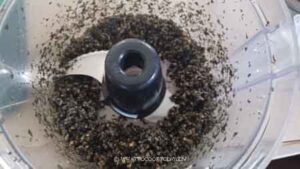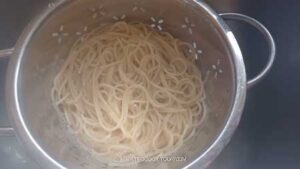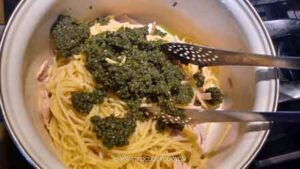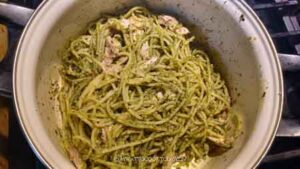This post may contain affiliate links. Please read our disclosure policy.
A fresh twist on classic pesto—this pasta with shiso pesto uses red shiso leaves (perilla) for a bold, earthy flavor. Perfect for putting summer’s shiso harvest to good use.

If you’ve ever grown herbs in your backyard, you know how sometimes you end up with way more than you can possibly use. A sweet friend recently shared giant bags of shiso leaves that her husband grew over the summer—TONS of them, bright purple-red and so fragrant. Her husband grew the red shiso variety, and they like to use the leaves to wrap meat and fish and eat them.
I didn’t want them to go to waste, so I thought, why not make a pesto with them? Even though green shiso is usually the one used for pesto, red shiso works beautifully too—it gives the sauce a darker, almost jewel-toned hue and a slightly earthier taste. And let me tell you, pasta with shiso pesto is such a fun twist on the classic basil pesto.
What Are Shiso Leaves?
Shiso leaves are part of the mint family, and they’re often referred to as perilla leaves. If you’ve had Japanese, Korean, or Southeast Asian dishes before, chances are you’ve tasted them. Shiso has a very distinctive flavor—herbal, slightly citrusy, a little spicy, with a faint hint of cinnamon or clove depending on the variety. It’s one of those herbs that you either love or aren’t quite sure what to do with at first.
The Different Types of Shiso
- Green Shiso (Ao Shiso) – The most commonly used in Japanese cooking. You’ll see it as a garnish with sashimi, wrapped around sushi, or mixed into salads and tempura.
- Red Shiso (Aka Shiso) – This is what my friend gave me. It’s often used to color and flavor pickled plums (umeboshi) or to make refreshing summer drinks like shiso juice. The leaves are a deep purple-red with an earthy flavor that’s slightly more robust than green shiso.
- Korean Perilla (Kkaennip) – These are bigger and heartier, often used to wrap grilled meats or pickled in soy sauce. The flavor leans more nutty and bold compared to Japanese shiso.
Why You’ll Like This Recipe
- A creative way to use up an abundance of shiso leaves.
- A unique twist on the classic basil pesto that feels both familiar and new.
- Comes together quickly—perfect for busy weeknights.
- Works not just for pasta but also as a spread on toast, pizza, or drizzled over grilled veggies.

Ingredients and Substitutions
- Red shiso leaves – You can also use green shiso or even a mix of shiso and basil if you prefer a milder taste.
- Garlic – Adds that punchy base note.
- Nuts – Traditionally, pesto uses pine nuts, but I often use walnuts or almonds since they’re more affordable.
- Parmesan cheese – Brings the salty, savory richness. If you want to make it vegan, use nutritional yeast instead.
- Olive oil – Use good quality extra virgin olive oil for the best flavor.
- Pasta – I use spaghetti, but feel free to use any long or short pasta here
- Salt & pepper
Frequently Asked Questions
- Can I freeze shiso pesto?
Yes! Freeze it in small portions (ice cube trays work great) so you can thaw just what you need. - Does red shiso taste different from green shiso in pesto?
Yes—red shiso is a little earthier and more robust, while green shiso is brighter and more citrusy. Both work beautifully, just slightly different in character. - What else can I do with shiso pesto besides pasta?
Spread it on sandwiches, swirl it into soups, top grilled fish or chicken, used it as a salad dressing, or drizzle over roasted vegetables.

I love how food always finds its way into our lives through friends and family. My friend’s generosity with her garden harvest inspired this dish, and now I can’t imagine not having a jar of shiso pesto in the fridge. If you ever find yourself with a ton of shiso leaves, give this pasta with shiso pesto a try—it’s simple, flavorful, and a little unexpected.
Pasta with Shiso Pesto
Ingredients
For shiso pesto
- 55 g shiso leaves
- 50 g pine nuts toasted for extra flavor
- 1 clove garlic crushed
- 100 g olive oil or oil of your choice, divided
- 40 g parmesan cheese finely grated, divided
For pasta:
- 250 g spaghetti or any long or short pasta works
- Salt and pepper to taste
Optional add ins:
- 336 g Shredded cooked chicken meat
Instructions
Prepare shiso pesto:
- Depending on the size of your food processor, mine is quite big, so I usually prepare double or triple batches or the pesto, because it's easier to process that way. Simply double or triple the pesto recipe. I keep the rest frozen in small batches and thaw them when I need them
- I toasted the pine nuts on a dry skillet until lightly golden brown over a medium heat.
- Put shiso leaves, toasted pine nuts, garlic, 1/8 tsp of salt, and freshly grind black pepper in a food processor. Give it a few pulses and scrape the sides of the bowl and pulse until you get a coarsely chopped paste.

- With the food processor running on low, gradually add 1/3 cup of the oil and mix until combined. Add 3/4 of the Parmesan cheese and pulse a few times to combine. Set aside or keep them in a jar stored in a fridge if not using on the same day

Cook the pasta:
- Bring a large pot of water to a boil. Add some salt according to the instruction on the package. Cook until al dente. Do not overcook them. Reserve about 1/2 cup of the cooking liquid and drain off the rest. DO NOT rinse the pasta so the pesto can cling to the pasta

- Return the pasta to the pot. Add the shiso pesto and about 1/4 cup of the reserved pasta liquid, and shredded cooked chicken meat if using (I usually use leftover rotisserie chicken meat).

- Give everything a gentle toss to combine. Make sure the pasta is coated with shiso pesto. If it seems dry, you can add a bit more liquid. Have a taste and adjust by adding more salt and pepper to your preference

To serve:
- Transfer the pasta to a serving plate. top with the rest of the Parmesan cheese and serve immediately
*Nutrition facts are just estimates and calculated using online tools*






